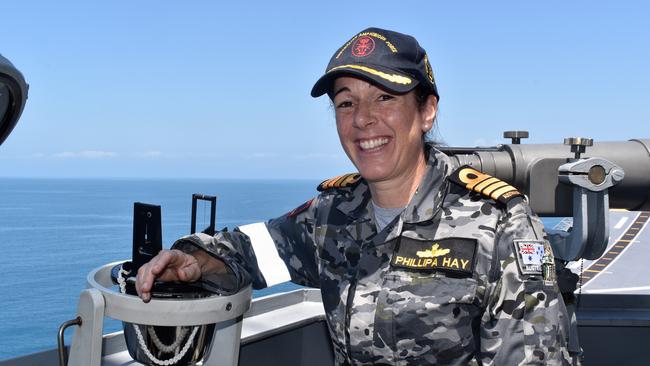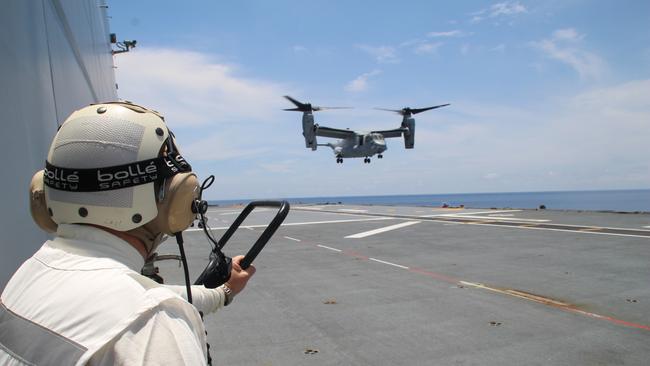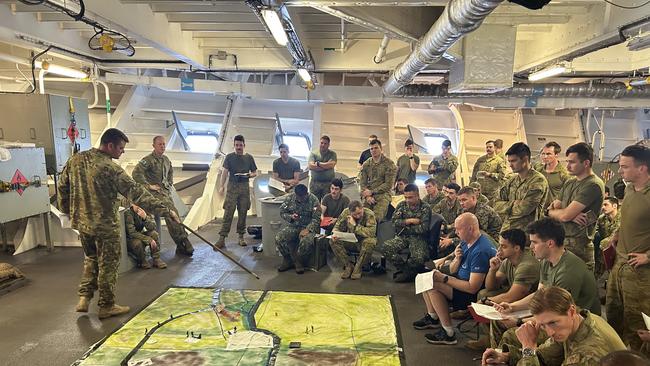Inside Australia’s HMAS Canberra and the young new faces of the ADF
The Australian Defence Force has given a rare look inside their HMAS ship and the new young faces leading the front line to protect the country.
National
Don't miss out on the headlines from National. Followed categories will be added to My News.
In near-total darkness, officer of the watch, Sub-Lieutenant Will Payne stands in the middle of the bridge of HMAS Canberra.
Around him a small team of crew are at their posts, illuminated by tiny, dim red lights or radar screens sweeping in arcs identifying atolls and fishing trawlers about their immediate waters off the coast of the Philippines on the South China Sea.
Observations are called out and acknowledged as radios crackle with foreign languages from passing traffic or crisp, acronymed reports from other sections of the ship.
It’s busy, but not noisy.

“Right now here, 22, 20, 27, 20 or maybe now 21, or by next week, I think,” Payne announces suddenly over the hushed-toned din of the wheelhouse, like an enthusiastic TV lottery caller.
But he is not announcing lucky numbers or issuing new co-ordinates.
He is revealing the ages of the crew on the after-dark watch of this huge amphibious assault ship, in the middle of one of the busiest and disputed waterways in the world, as below deck more than 1100 other crew and embarked forces are relaxing or at rest.
“It is incredible, hard to believe the responsibility of the ship right now is with a fairly young crew averaging early 20s, but this is how it is,” he says.
This is the face of the modern Australian Defence Force and particularly the Royal Australian Navy; young, sharp, tech-savvy and prepared to be alert and on the front line of our national defences while the rest of us sleep and largely take our national security for granted.

News Corp Australia joined the crew aboard HMAS Canberra on a mission from Australia to the South China Sea (also known as the West Philippine Sea) for bilateral military exercises with the Philippines.
It is one of the first times a civilian observer has been invited to sail aboard a RAN vessel on an active sea exercise as Defence opens the door on life in service.
On board also are 1100 military personnel, from the ADF, Armed Forces of the Philippines and US Marine Corps, along with their tanks, armoured vehicles, weapons and aircraft sailing in company with guided missile frigate HMAS Anzac, herself with a crew of about 200 young Australians.
Exercise Alon is a 17-day joint exercise to increase interoperability of tactics, techniques and equipment between allies as they conduct air, land and sea amphibious assault over the Philippines from HMAS Canberra.

It is an exercise that had been months in the making, but happens to coincide with China ratcheting its rhetoric around sovereignty of the whole South China Sea and the federal government flagging to have Australia join allied warships now patrolling the disputed body of water. For the crew, their sense of national duty is on par with the sense of urgency around their day-to-day activity. This is not a cruise-ship jolly and their age is not the only revelation of life at sea on board the pride of the navy fleet.

It feels cramped, even for a ship the size of HMAS Canberra, but that’s perhaps because this is a military ship, not a cruise ship; there are no windows, swimming pools or entertainment lounges. Just the equivalent of 10 storeys of decks to carry troops and equipment for humanitarian missions, disaster relief or crisis.
Despite the confines, there is almost a permanent bustle of activity, crew and forces moving through the ship with purpose. Physically and metaphorically, the ship just hums.
Without windows and only limited outdoor access, you could imagine being in a busy office space with the ship’s recreational rooms, mess halls and a gym space the envy of an Anytime Fitness centre.
“I just love it, doing the job, being at sea,” says Lt Commander Wes Truscott, who runs the ship’s primary care reception facility, or medical facility.

He joined the Navy when he was 15, stayed for 20 years then left to get into civilian health management. Truscott was director for a couple of Melbourne hospitals as well as director of Colac hospital and its 20 beds for a 50,000 population.
“Here we have 37 beds for up to 1400 people,” he says of the ship’s facilities and 50 staff including doctors, nurses, pharmacists, physios and other allied health workers. “We don’t always have our facility (hospital) full so the tempo will vary depending on what mission we are doing.
“The living conditions are different; when you are at sea for days, weeks or months on end, you are certainly working longer hours. A typical day for us starts at 7.30 and often we are going late into the night. We do have shifts but we are essentially day workers on call so the hours are longer.”
Able Seamen Koen Giblett and Danni Haebich, both 23, joined the navy to become medics, looking for adventure.
“I love it, being on a ship,” Haebich says. “It’s the community on the ship. You’re with the same great people to work with, but it’s just such a different lifestyle.

It’s really fun, everyone’s in the same situation away from home. It’s hard so you have to make the most of your surroundings but it’s a weirdly great environment. There are so many people on board but you still make so many great friends.”
Commander Amphibious Task Force, Captain Phillipa Hay, has spent a lifetime near water, growing up in Tasmania, sailing around the world on her parents’ yacht when she was 10. She was one of the first women at sea, and after 31 years in the navy, she says no day is the same. “Life at sea is, well, like a family,” she says of the need to be patient with fellow crew after weeks at sea.
“We get to see each other day, night, at best and at worst so we have to look after one another and be patient with one another. There is no escaping. Some people do find it gets a bit much; your bunk is sacred. Don’t put your book or hat on someone else’s bunk, that’s their space … but there’s always somebody around.

“Every day is different … every day this ship lets go its lines to sea, casts off the rope. We are doing operations – if right now an emergency beacon goes off and we are the closest ship, we will respond. Typhoon, disaster … be assured we would respond. We have a program, but are always fully armed, crewed, fully fuelled ready to do what we need to do.”
The Spanish-built HMAS Canberra is 235m long and, with multiple decks linked by a network of staircases, or ladder bays, it is easy to get lost. Each door to the stairwells is lettered and numbered, but there are two that are critical to commit to memory. No. 138 (“she’s your mate”) gives access to the entire ship, while No. 161 (“she’s for fun”) gives access to the gangway and potential escape in an emergency.
A four-page document titled Daily Orders is printed every day and pinned on noticeboards and sent out on the ship’s intranet.
Like a newsletter, it spells out everything in detail from maintenance schedules to training activities, the ship’s general course, drills and everything in between the three daily 30-minute meal timeslots. There are also recreational activity promotions – on this trip, a call for volunteers to contribute to an HMAS Canberra cookbook. Each order is followed to the letter, says Captain Brendan O’Hara.

In his younger days, O’Hara was a Big W trolley boy in Canberra working his way up to loading dock manager. Now, 24 years later, and after command of two other ships, he assumed command of the Canberra in May.
He calls his crew a team because they are tri-service, so not just navy sailors. But they are also a team because they are empowered to offer their thoughts on elements of the running of the ship. “Once you empower people, regardless of rank, that’s where the value comes from and that gives them the motivation that ‘yes, I want to go to work because I have an opportunity to make a difference’, an opportunity to improve their skills, improve their knowledge or demonstrate those skills and knowledge with the freedom to do that,” he says.
He says the young crew is tech-smart and keen to work efficiently and suggest fresh ways to do it. “What I’m trying to do on this ship, and I’ve only been here a short time, is really just stressing to people, ‘Hey, you know what you’ve got to do, get on and do it’,” he says. “You don’t micromanage, you give them the left and right of arc and you just say, ‘well, this is what we have got to achieve’ … how they go about that within policy, it’s amazing what they achieve.”

As an amphibious ship able to carry 1000 troops, you can imagine the kitchen (galley) is big. Double that thought – it’s immense, with walk-in fridges alone the size of an average four-bedroom home. They have to be able to carry a lot of food for four hot meals a day. Four menu choices, including a vegetarian, each for dinner and lunch. The quality is extraordinarily good, but then many of the 29 chefs on board operated their own restaurants and cafes before entering the navy and love the challenge of cooking nutritional quality for huge 30-minute sittings for 1400 people from four serving sites.
Think of a cube with the giant kitchen in the middle and staff serving all sides from the centre. Because of the ship’s 24/7 operations, there are four meals a day of roasts, curries, stir-fries, fish and chips – the options are endless.
The biggest issue is when one of the dishwashers breaks down. The machines wash more than 4000 plates a day, plus cups, side plates, bowls and cutlery.

Chef and galley manager, Petty Officer Simon Wild, says fresh food lasts a couple of weeks then they have to get creative with frozen goods, but quality is maintained and customers never complain. “The heart of the ship is the galley, it is really where all the morale happens and we get to see everyone every day, the junior non-commissioned officer, NCOs and officers, all the embarked forces all come here, they all get the same food.”
They load an average 52 giant pallets of food for each mission, including up to three tonnes of uncooked rice (with an average of 80kg of rice consumed a day) to cover six weeks at sea. The ship goes through an average 24 large jars of Vegemite a day so there’s a whole pallet of the condiment and a paddock’s worth of beef steak and lamb chops. Lime cordial is the drink of choice, with water made from a desal plant on the ship producing 54m-squared of water a day.
Commander Karl Brinkmann has been in the navy for 35½ years and has a simple philosophy for being at sea.

“If you wake up in the morning and manage to smile during the day and you go to bed and you’re slightly smarter than when you woke up, you’re having a good day,” he says. “Everything else is a bonus and a benefit.”
When he first went to sea in 1988, they had to reconfigure a ham radio to listen to the rugby union World Cup. Now there are TVs around the ship to watch movies and news from Australia. Information warfare officer, Major Julian Thirkill, a former British infantry officer who transferred to the ADF in 2005, says a ship has to be considered a town.
“It’s like a town in the sense that you’ve got your characters, you’ve got your good neighbours, you’ve got your bad neighbours, you’ve got people who live in the town year-round then you’ve got other people who come in and out seasonally, like when we have an exercise or operation when you’ve got embark forces, like tourists coming to a seaside town, then leave,” he says.

“The ship’s crew are like the year-round residents. Equally with personalities, you’ve got the postman, you’ve got the chaplain, PTI (physical training instructor); some live on the north and south of town, they get haircuts, use bank facilities, ship’s office, a shop, laundry. You go to work, you go home, it’s life.”
Back on the bridge, 20-year-old Seaman, Boatswain’s Mate Jeremy Nunn, is on lookout duty. “I just love going out to sea,” he says, while looking through giant binoculars towards a Filipino island.
“Life at sea, there’s a good routine, there is an amazing crew. Yes, there are a lot of (young) people around my age.
“I’ve made a lot of friends. I don’t know where else I would be if I wasn’t here.”
More Coverage
Originally published as Inside Australia’s HMAS Canberra and the young new faces of the ADF




